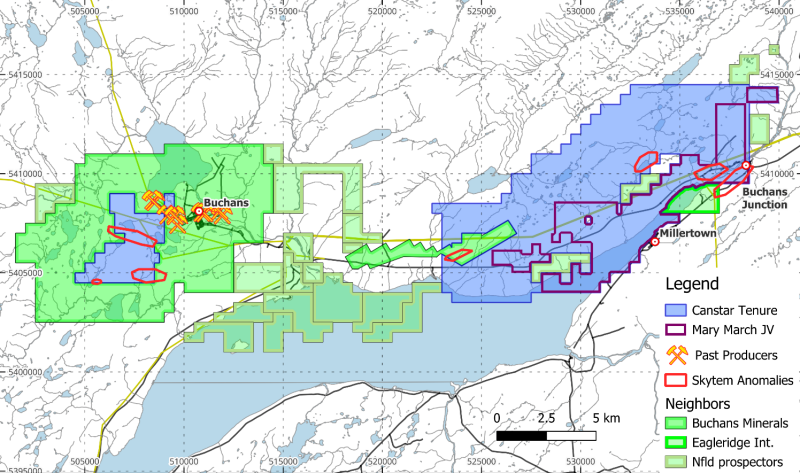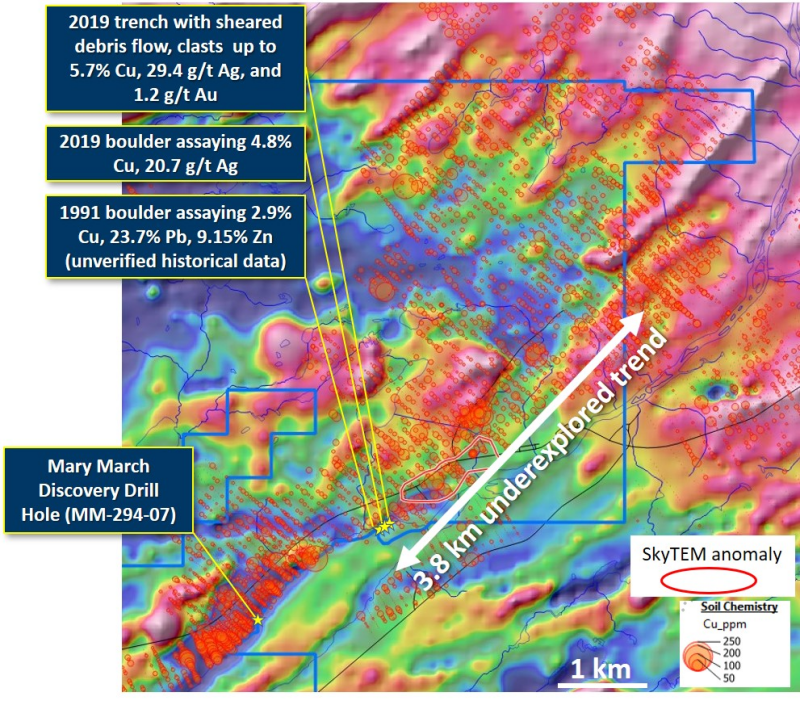Archive
Canstar Completes Historic Data Compilation on Buchans-Mary March VMS Claims, Defines Exploration Targets
 | |||||||||
 | |||||||||
Toronto, Ontario – TheNewswire - December 14, 2023 – CANSTAR RESOURCES INC. (TSXV:ROX) & (OTC:CSRNF) (“Canstar” or the “Company”) is pleased to announce that it has completed the compilation of a large amount of historic data relating to its claims in the vicinity of the historic Buchans Mine in Central Newfoundland.
The Buchans Mine operated for 58 years, processing 16.2 million tonnes of ore from five Volcanic-hosted Massive Sulphide (“VMS”) ore bodies with an average grade of 14.5% zinc (“Zn”), 7.6% lead (“Pb”), 1.33% copper (“Cu”), 126 g/t silver (“Ag”), and 1.37 g/t gold (“Au”) (unverified historic data). It was one of the highest grade base metal mining camps in Canadian history and remains relatively underexplored for such a high-grade VMS district.
The Company currently holds 10,511 hectares (105 km2) of mineral claims (100% Canstar) in the Buchans area (the “Buchans Claims”) including 2,834 hectares (28 km2) of mineral claims under a joint venture agreement with Glencore Canada (the “Mary March JV Claims”), with Canstar holding 56% and acting as operator (Figure 1).
Rob Bruggeman, President and CEO, stated: “The Canstar exploration team has been focused almost entirely on the Golden Baie project for the past three years due to the large size of that project. This year we had time to review our other significant mineral claim package in Newfoundland, the Buchans-Mary March project. An extensive amount of historic data was compiled in order to better understand the exploration potential of the Buchans-Mary March claims and to develop a future work program.
Having untested EM targets and a trend almost 4 kilometres long with little exploration in a high-grade VMS camp is quite exciting, especially as the world looks for new sources of critical metals like copper and zinc from mining-friendly jurisdictions.”
Highlights of the Buchans Claims and Data Compilation
-
Buchans VMS deposits are prolific due to high grades of Zn, Pb, Cu, Ag and Au mineralization.
-
Compared to other VMS camps, the Buchans area has had little modern, systematic exploration
-
The Buchans Claims have good road access, power lines, and local communities. Exploration and drilling costs in the Buchans area are relatively low due to these factors.
-
A 2017 SkyTEM Time-Domain Airborne Electromagnetic survey highlighted multiple electromagnetic (“EM”) anomalies. EM anomalies in VMS districts can coincide with massive sulphides or alteration associated with localized hydrothermal venting. The EM anomalies on the Company’s claims have had only shallow, wide-spaced drill testing and remain prime exploration targets.
-
Drilling on the Mary March JV Claims in the 1990s resulted in the best drill intercepts outside of the Buchans Mine area (all are historic unverified assays):
-
MM-294-3 – 4.2 g/t Au, 122 g/t Ag, 10.1% Zn, 1.8% Pb, 0.64% Cu over 9.63 metres (“m”);
-
MM-294-3 – 72.4 g/t Ag, 3.0% Zn, 1.1% Pb, and 0.13% Cu over 20.6 m; and
-
MM-294-11 – 12.2 g/t Au, 660 g/t Ag, 16.8% Zn, 5.4% Pb, and 0.2% Cu over 0.91 m.
-
-
The Mary March drill intercepts are on strike with a 3.8 kilometre (“km”) structural trend containing rock grab samples grading up to 5.7% Cu, 29.4 g/t Ag and 1.2 g/t Au1 from a 2019 trench (see news release dated Sep. 9, 2019 and Figure 2). This 5 km trend has never been drill tested
Figure 1 - Canstar Mineral Tenements near the Buchans Mine in central Newfoundland
Buchans-Mary March Data Compilation
Recently, Canstar completed work towards a standardized of historic work on its claims. As a result, the Company has assembled a surficial geochemistry database of 13,136 soil samples, and 2,430 basal tills. The database includes data from more than 3,500 drill holes in the area, of which 236 historic drill holes are on Canstar’s claims. The Company’s team is working on standardizing and incorporating data from these drillholes including assays, lithology logs and whole rock geochemistry.
Despite the long history of mineral exploration around the Buchans mine, the work has been sporadic and tightly clustered around areas of early success leaving large areas relatively untouched and many strong indications that have not been followed up. Canstar’s exploration team has used the 2017 SkyTEM survey to identify seven underexplored EM anomalies, only two of which have been tested by historic drilling.
Mary March Target Area
Historic drilling on the Mary March JV claims in the 1990s yielded the best drill results outside of the Bucans Mine area. The original Mary March discovery hole intercepted 4.2 g/t Au, 122 g/t Ag, 10.1% Zn, 1.8% Pb, and 0.64% Cu over 9.63 m (unverified historical assay). The 2017 SkyTEM survey did not cover this area (as it was not commissioned by Canstar) but it did identify an EM anomaly 1,800 m along strike to the east that extends the full 1,000 m width of the survey in that location. In total, the Mary March trend has the potential to span 5,600 m, of which only 1,000m has been drilled to date. 3D modeling of the area has been completed, incorporating the drilling around the historic intercept and demonstrating the potential for the mineralization to extend along strike to the EM anomaly, which has not been drill tested.
In 2019, Canstar excavated a single trench located 1.8 km along strike from the Mary March discovery hole, MM-294-7. A 4.5 m wide zone of sheared and strongly sericite altered felsic volcanic rocks containing a number of rotated clasts or fragments of copper and gold bearing pyritic massive sulphides were identified in the trench. Highlights from the massive sulphide grab samples collected in trench MM-TR-01 included (see news release dated Sep.9, 2019):
-
1.1 g/t Au, 29.4 g/t Ag, and 5.7% Cu
-
1.5 g/t Au, 54.2 g/t Ag, and 2.3% Cu
-
1.9 g/t Au, 23.5 g/t Ag, and 1.1% Cu
The rock seen in trench MM-TR-01 is interpreted as debris flow containing clasts of massive sulphide, a pronounced characteristic of some of the Buchans deposits. This area also coincides with a strong EM anomaly detected in the 2017 SkyTEM regional airborne survey. The only nearby historic drill hole was drilled 80 m to the southwest and reportedly intercepted 37 m of altered felsic volcanic rock, potentially the footwall to mineralization.
As illustrated in Figure 2, the interpreted airborne magnetic data shows a potential trend approximately 5 km long that includes the historic discovery drill hole, trench MM-TR-01 samples, as well as historic copper-in-soil anomalies. Approximately 3.8 km of this trend has seen little exploration and is a priority target.
Figure 2 - Mary March target area magnetic base map with copper-in-soils
Qualified Person
Matthieu Lapointe, B.Sc., P.Geo., Vice President Exploration of Canstar, and a Qualified Person as defined by National Instrument 43-101 - Standards of Disclosure for Mineral Projects, is responsible for the scientific and technical data presented herein and has reviewed and approved this release.
Acknowledgements
Canstar wishes to acknowledge the financial support of the 2023 exploration programs through the Junior Exploration Assistance Program from the Department of Natural Resources, Government of Newfoundland and Labrador.
About Canstar Resources Inc.
Canstar Resources has a very experienced technical team and board who are focused on new mineral discoveries in Newfoundland, Canada. Central Newfoundland has emerged as one of the most exciting gold exploration districts due to recent high-grade orogenic gold discoveries along crustal scale fault corridors. The Company is focused on gold exploration on the district-scale Golden Baie project in south-central Newfoundland, which has multiple high-grade gold anomalies at surface along ~100 km of strike and near-surface drilling confirming the presence of high-grade orogenic gold. The Company also holds the Buchans-Mary March project in central Newfoundland.
Canstar Resources is based in Toronto, Canada, and is listed on the TSX Venture Exchange under the symbol ROX and trades on the OTCPK under the symbol CSRNF.
For further information, please contact:
Rob Bruggeman, President & CEO
Email: rob@canstarresources.com
Phone: 1-647-247-8715
Website:www.canstarresources.com
Forward-Looking Statements
Neither TSX Venture Exchange nor its Regulation Services Provider (as that term is defined in the policies of the TSX Venture Exchange) accepts responsibility for the adequacy or accuracy of this release.
This News Release includes certain "forward-looking statements" which are not comprised of historical facts. Forward looking statements include estimates and statements that describe the Company’s future plans, objectives or goals, including words to the effect that the Company or management expects a stated condition or result to occur. Forward looking statements may be identified by such terms as “believes”, “anticipates”, “expects”, “estimates”, “may”, “could”, “would”, “will”, or “plan”. Since forward-looking statements are based on assumptions and address future events and conditions, by their very nature they involve inherent risks and uncertainties. Although these statements are based on information currently available to the Company, the Company provides no assurance that actual results will meet management’s expectations. Risks, uncertainties and other factors involved with forward-looking information could cause actual events, results, performance, prospects and opportunities to differ materially from those expressed or implied by such forward-looking information. Forward looking information in this news release includes, but is not limited to, the Company’s objectives, goals or future plans, statements, exploration results, potential mineralization, the estimation of mineral resources, exploration and mine development plans, timing of the commencement of operations and estimates of market conditions. Factors that could cause actual results to differ materially from such forward-looking information include, but are not limited to failure to identify mineral resources, failure to convert estimated mineral resources to reserves, the inability to complete a feasibility study which recommends a production decision, the preliminary nature of metallurgical test results, delays in obtaining or failures to obtain required governmental, environmental or other project approvals, political risks, inability to fulfill the duty to accommodate First Nations and other indigenous peoples, uncertainties relating to the availability and costs of financing needed in the future, changes in equity markets, inflation, changes in exchange rates, fluctuations in commodity prices, delays in the development of projects, capital and operating costs varying significantly from estimates and the other risks involved in the mineral exploration and development industry, an inability to predict and counteract the effects of COVID-19 on the business of the Company, including but not limited to the effects of COVID-19 on the price of commodities, capital market conditions, restriction on labour and international travel and supply chains, and those risks set out in the Company’s public documents filed on SEDAR. Although the Company believes that the assumptions and factors used in preparing the forward-looking information in this news release are reasonable, undue reliance should not be placed on such information, which only applies as of the date of this news release, and no assurance can be given that such events will occur in the disclosed time frames or at all. The Company disclaims any intention or obligation to update or revise any forward-looking information, whether as a result of new information, future events or otherwise, other than as required by law.
1 Readers are advised that rock grab samples are selective by nature and values reported may not represent the true grade or style of mineralization across the property.

